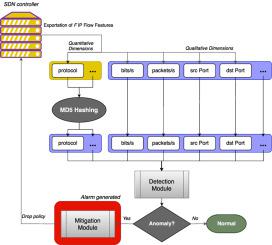Journal of Network and Computer Applications ( IF 7.7 ) Pub Date : 2020-12-29 , DOI: 10.1016/j.jnca.2020.102942 Marcos V.O. Assis , Luiz F. Carvalho , Jaime Lloret , Mario L. Proença

|
The management of modern network environments is becoming more and more complex due to new requirements of devices' heterogeneity regarding the popularization of the Internet of Things (IoT), as well as the dynamic traffic required by next-generation applications and services. To address this problem, Software-defined Networking (SDN) emerges as a management paradigm able to handle these problems through a centralized high-level network approach. However, this centralized characteristic also creates a critical failure spot since the central controller may be targeted by malicious users aiming to impair the network operation. This paper proposes an SDN defense system based on the analysis of single IP flow records, which uses the Gated Recurrent Units (GRU) deep learning method to detect DDoS and intrusion attacks. This direct flow inspection enables faster mitigation responses, minimizing the attack's impact over the SDN. The proposed model is tested against several different machine learning approaches over two public datasets, the CICDDoS 2019 and the CICIDS 2018. Furthermore, a lightweight mitigation approach is presented and evaluated through performance tests regarding each detection method. Finally, a feasibility test is performed regarding the throughput of flows per second that each detection method can analyze. This test is accomplished through the use of real IP Flow data collected at a large-scale network. The results point out promising detection rates and an elevated amount of analyzed flows per second, which makes GRU a feasible approach for the proposed system.
中文翻译:

GRU深度学习系统,可抵御软件定义网络中的攻击
由于有关物联网(IoT)普及的设备异质性的新要求以及下一代应用程序和服务所需的动态流量,现代网络环境的管理正变得越来越复杂。为了解决这个问题,软件定义网络(SDN)成为一种管理范式,它可以通过集中式高级网络方法来处理这些问题。但是,由于中央控制器可能会受到旨在破坏网络运行的恶意用户的攻击,因此这种集中式特征还会造成严重的故障点。本文提出了一种基于单个IP流记录分析的SDN防御系统,该系统使用门控循环单元(GRU)深度学习方法检测DDoS和入侵攻击。这种直接流检查可实现更快的缓解响应,从而最大程度地降低了攻击对SDN的影响。在两个公共数据集CICDDoS 2019和CICIDS 2018上,针对几种不同的机器学习方法对提出的模型进行了测试。此外,提出了一种轻量级的缓解方法并通过针对每种检测方法的性能测试进行了评估。最后,对每种检测方法可以分析的每秒流量的吞吐量进行可行性测试。该测试是通过使用在大型网络上收集的真实IP流数据来完成的。结果表明有希望的检测率和每秒增加的分析流量,这使得GRU成为所提出系统的可行方法。对SDN的影响。在两个公共数据集CICDDoS 2019和CICIDS 2018上,针对几种不同的机器学习方法对提出的模型进行了测试。此外,提出了一种轻量级的缓解方法并通过针对每种检测方法的性能测试进行了评估。最后,对每种检测方法可以分析的每秒流量的吞吐量进行可行性测试。该测试是通过使用在大型网络上收集的真实IP流数据来完成的。结果表明有希望的检测率和每秒增加的分析流量,这使得GRU成为所提出系统的可行方法。对SDN的影响。在两个公共数据集CICDDoS 2019和CICIDS 2018上,针对几种不同的机器学习方法对提出的模型进行了测试。此外,提出了一种轻量级的缓解方法并通过针对每种检测方法的性能测试进行了评估。最后,对每种检测方法可以分析的每秒流量的吞吐量进行可行性测试。该测试是通过使用在大型网络上收集的真实IP流数据来完成的。结果表明有希望的检测率和每秒增加的分析流量,这使得GRU成为所提出系统的可行方法。提出了一种轻量级的缓解方法,并通过针对每种检测方法的性能测试进行了评估。最后,对每种检测方法可以分析的每秒流量的吞吐量进行可行性测试。该测试是通过使用在大型网络上收集的真实IP流数据来完成的。结果表明有希望的检测率和每秒增加的分析流量,这使得GRU成为所提出系统的可行方法。提出了一种轻量级的缓解方法,并通过针对每种检测方法的性能测试进行了评估。最后,对每种检测方法可以分析的每秒流量的吞吐量进行可行性测试。该测试是通过使用在大型网络上收集的真实IP流数据来完成的。结果表明有希望的检测率和每秒增加的分析流量,这使得GRU成为所提出系统的可行方法。











































 京公网安备 11010802027423号
京公网安备 11010802027423号